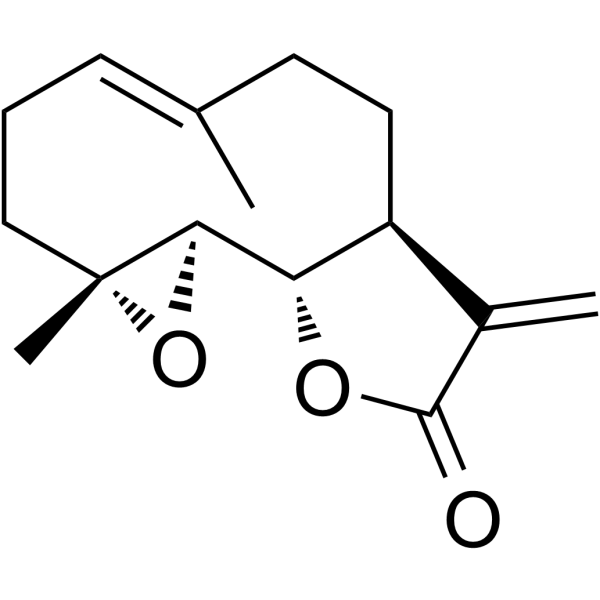上海金畔生物科技有限公司提供天然产物萜类及其苷类Terpenoids and Glycosides。
Parthenolide (Synonyms: 小白菊内酯; (-)-Parthenolide) 纯度: 99.13%
Parthenolide是在药草短舌匹菊中发现的倍半萜内酯。 Parthenolide通过抑制 NF-κB 活化而表现出抗炎活性; 它还可抑制 HDAC1 蛋白而不影响其他I/II类HDAC。

Parthenolide Chemical Structure
CAS No. : 20554-84-1
| 规格 | 价格 | 是否有货 | 数量 |
|---|---|---|---|
| Free Sample (0.1-0.5 mg) | Apply now | ||
| 10 mM * 1 mL in DMSO | ¥550 | In-stock | |
| 50 mg | ¥500 | In-stock | |
| 100 mg | ¥700 | In-stock | |
| 200 mg | ¥1100 | In-stock | |
| 500 mg | 询价 | ||
| 1 g | 询价 |
* Please select Quantity before adding items.
Parthenolide 相关产品
•相关化合物库:
- Covalent Screening Library Plus
- Natural Product Library Plus
- Drug Repurposing Compound Library Plus
- Clinical Compound Library Plus
- Bioactive Compound Library Plus
- Apoptosis Compound Library
- Immunology/Inflammation Compound Library
- NF-κB Signaling Compound Library
- Stem Cell Signaling Compound Library
- Natural Product Library
- Anti-Cancer Compound Library
- Clinical Compound Library
- Autophagy Compound Library
- Anti-Aging Compound Library
- Drug Repurposing Compound Library
- Covalent Screening Library
- Antioxidants Compound Library
- Differentiation Inducing Compound Library
- Oxygen Sensing Compound Library
- Anti-COVID-19 Compound Library
- Medicine Food Homology Compound Library
- Terpenoids Library
- Pyroptosis Compound Library
- Traditional Chinese Medicine Monomer Library
- FDA Approved & Pharmacopeial Drug Library
- Anti-Breast Cancer Compound Library
- Anti-Lung Cancer Compound Library
- Anti-Pancreatic Cancer Compound Library
- Anti-Blood Cancer Compound Library
- Anti-Obesity Compound Library
- Mitochondria-Targeted Compound Library
- Transcription Factor Targeted Library
- Food-Sourced Compound Library
- Anti-Liver Cancer Compound Library
| 生物活性 |
Parthenolide is a sesquiterpene lactone found in the medicinal herb Feverfew. Parthenolide exhibits anti-inflammatory activity by inhibiting NF-κB activation; also inhibits HDAC1 protein without affecting other class I/II HDACs. |
||||||||||||||||
|---|---|---|---|---|---|---|---|---|---|---|---|---|---|---|---|---|---|
| IC50 & Target[1] |
|
||||||||||||||||
| 体外研究 (In Vitro) |
Parthenolide (PTL) has a dose-dependent growth inhibition effect on NSCLC cells Calu-1, H1792, A549, H1299, H157, and H460. Parthenolide can induce cleavage of apoptotic proteins such as CASP8, CASP9, CASP3 and PARP1 both in concentration- and time-dependent manner in tested lung cancer cells, indicating that apoptosis is trigged after Parthenolide exposure. In addition to induction of apoptosis, Parthenolide also induces G0/G1 cell cycle arrest in a concentration-dependent manner in A549 cells and G2/M cell cycle arrest in H1792 cells[2]. Shanghai Jinpan Biotech Co Ltd has not independently confirmed the accuracy of these methods. They are for reference only. |
||||||||||||||||
| 体内研究 (In Vivo) |
Only Parthenolide, the HDAC inhibitor with anti-inflammatory features, displayed a potent anti-apoptotic effect in Phb1 KO hepatocytes. Indeed, TSA and Parthenolide-treated hepatocytes showed increased levels of FXR, and reduced levels of CYP7A1, HDAC4, TNFα, TRAIL and Bax suggesting a less toxic effect of bile acids as a results of specific HDAC inhibition, resulting in the attenuation of the Phb1 KO hepatocytes apoptotic response. Importantly, Parthenolide exerts a protective effect from the liver injury after BDL in Phb1 KO mice. Indeed, Parthenolide treatment results in a reduction of the mortality rate of this mice after BDL associated with a lower apoptotic response as revealed by a reduction of necrotic areas, Tunel-staining, as well as decreased ALT (8431±957 vs.4225±210 U/L) and AST (4805±300 vs.2242±438 U/L) activities compared to control Phb1 KO mice[3]. Shanghai Jinpan Biotech Co Ltd has not independently confirmed the accuracy of these methods. They are for reference only. |
||||||||||||||||
| Clinical Trial |
|
||||||||||||||||
| 分子量 |
248.32 |
||||||||||||||||
| Formula |
C15H20O3 |
||||||||||||||||
| CAS 号 |
20554-84-1 |
||||||||||||||||
| 中文名称 |
小白菊内酯;银胶菊内酯 |
||||||||||||||||
| 运输条件 |
Room temperature in continental US; may vary elsewhere. |
||||||||||||||||
| 储存方式 |
|
||||||||||||||||
| 溶解性数据 |
In Vitro:
DMSO : ≥ 100 mg/mL (402.71 mM) H2O : < 0.1 mg/mL (insoluble) * “≥” means soluble, but saturation unknown. 配制储备液
*
请根据产品在不同溶剂中的溶解度选择合适的溶剂配制储备液;一旦配成溶液,请分装保存,避免反复冻融造成的产品失效。 In Vivo:
请根据您的实验动物和给药方式选择适当的溶解方案。以下溶解方案都请先按照 In Vitro 方式配制澄清的储备液,再依次添加助溶剂: ——为保证实验结果的可靠性,澄清的储备液可以根据储存条件,适当保存;体内实验的工作液,建议您现用现配,当天使用; 以下溶剂前显示的百
|
||||||||||||||||
| 参考文献 |
|
| Cell Assay [2] |
Human lung cancer cell lines are seeded in 96-well plates and treated on the second day with the given concentration of Parthenolide (0, 5, 10, 20 μM) for another 48 hours and then subjected to SRB or MTT assay. For SRB assay, live cell number is estimated as described earlier. After treatment, the medium is discarded firstly. In order to fix the adherent cells, 100 μL of cold trichloroacetic acid (10% (w/v)) are adding to each well and incubating at 4°C for at least 1 hour. The plates are then washed five times with deionized water and dried in the air. Each well are then added with 50 μL of SRB solution (0.4% w/v in 1% acetic acid) and incubated for 5 min at room temperature. The plates are washed five times with 1% acetic acid to remove unbound SRB and then air dried. The residual bound SRB is solubilized with 100 μL of 10 mM Tris base buffer (pH 10.5), and then read using a microtiter plate reader at 495 nm. The MTT assay is executed. 20 μL MTT (5 mg/mL) are added to each sample and incubate at 37°C for 4 h, then 100 μL solubilization solution are added. Cell viability is determined at 595 nm[2]. Shanghai Jinpan Biotech Co Ltd has not independently confirmed the accuracy of these methods. They are for reference only. |
|---|---|
| Animal Administration [3] |
Mice[3] Shanghai Jinpan Biotech Co Ltd has not independently confirmed the accuracy of these methods. They are for reference only. |
| 参考文献 |
|
